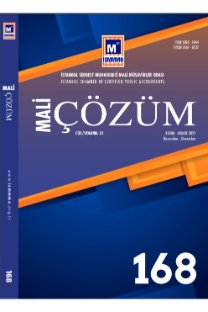ASİMETRİK MALİYET DAVRANIŞI TEORİSİ AÇISINDAN ŞİRKETLERİN MALİYET DAVRANIŞLARININ İNCELENMESİ: THY, TURKCELL VE TÜPRAŞ ÖRNEĞİ
Ticarette ülke sınırlarının ortadan kalkmasıyla oluşan rekabet ortamında maliyet (gider) yönetimi daha da önem kazanmıştır. Etkin bir maliyet yönetimi için maliyet davranışının doğru anlaşılması önem arz etmektedir. Maliyet muhasebesinin temel varsayımı; faaliyet hacmindeki artış ve azalış karşısında maliyetlerin (giderlerin) simetrik olarak hareket ettiği şeklindedir. Literatürde; hacimdeki yükselişe paralel olarak maliyetlerdeki (giderlerdeki) artışın, hacimdeki düşüşe bağlı olarak yaşanan azalmadan daha fazla olduğu yönünde çalışmalara rastlanmaktadır. Bu çalışmanın temel amacı; maliyetlerin simetrik olarak hareket edip etmediğinin test edilmesi şeklinde belirlenmiştir. Çalışmada, 2005Q1 – 2018Q3 dönemleri için BIST 30 endeksinde işlem gören 3 işletmenin finansal verilerinden yararlanılmıştır. Çalışmada araştırma hipotezlerinin test edilmesi için çoklu doğrusal regresyon yöntemi kullanılmıştır. Çalışmada, asimetrik maliyet davranışının geçerli olduğu yönünde bulgular elde edilmiştir. Bu sonuca ek olarak çalışmada, asimetrik maliyet davranışının işletmenin içinde bulunduğu ekonomik çevreden etkilendiği tespit edilmiştir.
ANALYSIS OF THE COST BEHAVIOURS OF THE COMPANIES IN TERMS OF ASYMMETRIC COST BEHAVIOUR THEORY: THY, TURKCELL AND TÜPRAŞ
In competitive environment arising as because of the removal of the commercial borders between countries, businesses have raised the importance given to cost management. A fundamental assumption in cost accounting is that the relation between costs and volume is symmetric for volume increases and decreases. There are several studies which find that costs increase more when activity rises than they decrease when activity falls by an equivalent amount. The aim of this study is to test whether costs behavior is symmetric for volume increases and decreases. We test hypothesis by Multiple Linear Regression Analysis Method using financial data of 3 firms listing at BIST 30 over the period from 2005Q1 to 2018Q3. We find support in favor of asymmetric cost behavior. In addition to this, we investigate that asymmetric cost behavior is affected by different competition environments.
___
- Anderson, M. C., Banker, R. D. and Janakiraman, S. N. (2003). Are selling, general, and administrative costs “sticky”?. Journal of Accounting Research, 41 (1), 43-63.
- Argilés, J. M. and Garcia-Blandon, J. (2009). Cost stickiness revisited: empirical application for farms. Spanish Journal of Finance And Accounting, 38 (144), 579-605.
- Balakrishnan, R. and Gruca, T. S. (2008). Cost stickiness and core competency: a note. Contemporary Accounting Research, 25 (4), 993-1006.
- Banker, R. D., T. Byzalov, D. and Chen, L. (2013). Employment protection legislation, adjustment costs and cross-country differences in cost behavior. Journal of Accounting and Economics, 55 (1), 111-127.
- Banker, R., Byzalov, D. (2014). Asymmetric Cost Behavior. Journal Of Management Accounting Research, 26 (2), 43-79.
- Banker, R., Byzalov, D. (2014). Asymmetric Cost Behavior. Journal Of Management Accounting Research, 26 (2), 43-79.
- Baumgarten, D. (2012). The cost stickiness phenoenon: causes, characteristics, and ımpliations for fundamental analysis and financial analysts’ forecasts. Springer Gabler, Cologne.
- Calleja, K., Steliaros, M. ve Thomas, D. C. (2006). A note on cost stickiness: some international comparisons. Management Accounting Research, 17 (2), 127-140.
- Chen, C. X., Lu, H. and Sougiannis, T. (2012). The agency problem, corporate governance, and the asymmetrical behavior of selling, general, and administrative costs. Contemporary Accounting Research, 29 (1), 252-282.
- Dierynck, B., Landsman, W. R. and Renders, A. (2010). Do managerial ıncentives drive cost behavior? evidence about the role of the zero earnings benchmark for labor cost behavior in private belgian firms. American Accounting Association, 87 (4), 1219-1246.
- Greene, W. H. (2003). Econometric analysis. New Jersey: Prentice Hall.
- Gujarati, D. N. (2002). Basic econometrics. New York: McGraw-Hill.
- Hartlieb, S. and Loy, T. R. (2018). Evidence on the trade-off between cost stickiness and ıncome smoothing (October 8, 2018). AAA 2017 Management Accounting Section (MAS) Meeting.
- Kama, I. and Weiss, D. (2013). Do earnings targets and managerial ıncentives affect sticky costs. Journal of Accounting Research, 51 (1), 201- 224.
- Magheed, B. A. (2016). The determines of the sticky cost behavior in the jordanian ındustrial companies listed in amman stock market. Journal of Accounting - Business & Management, 23 (1), 64-81.
- Noreen, E. and Soderstrom, N. (1997). The accuracy of proportional cost models: evidence from hospital service departments. Review of Accounting Studies, 2 (1), 89-114.
- Pervan, M. and Pervan, I. (2012). Analysis of sticky costs: Croatian Evidence” Proceedings of the 4th WSEAS World Multiconference on Applied Economics. Business and Development (AEBD’12), 1-3 July, Porto, Portugal.
- Rouxelin, F., Wongsunwai, W. ve Yehuda, N. (2015). Aggregate cost stickiness in GAAp financial statement and future unemployment rate. Working Paper
- Weiss, D. (2010). Cost behavior and analysts’ earnings forecasts. The Accounting Review, 85 (4), 1441-1444.
- Yazarkan, H. ve Alperen, M. Y. (2016). Asimetrik maliyet davranışı teorisi borsa istanbul şirketlerinde sektörel bir karşılaştırma. Ankara: Detay Yayıncılık.
- ISSN: 1303-5444
- Yayın Aralığı: Yılda 6 Sayı
- Başlangıç: 1991
- Yayıncı: İstanbul Serbest Muhasebeci Mali Müşavirler Odası
Sayıdaki Diğer Makaleler
TÜRKİYE’DE SİGORTA HİLELERİNİN SEYRİ
ÖZEL USULSÜZLÜK KABAHATİ VE CEZASINA AİT DEĞERLENDİRMELER
KONTROL EDİLEBİLEN RİSKLER VE RİSK YÖNETİMİ AÇIKLAMALARI: BORSA İSTANBUL UYGULAMASI
Çağla DEMİR PALİ, Burcu ADİLOĞLU
STOK DENETİMİNDE NESNELERİN İNTERNETİ VE RADYO FREKANSI İLE TANIMLAMA TEKNOLOJİSİNİN ETKİLEŞİMİ
BİR KÂR YÖNETİMİ ARACI OLARAK SINIFLANDIRMA DEĞİŞTİRMESİ: LİTERATÜR İNCELEMESİ
DENETİM RAPORLARININ YAYINLANMA SÜRESİNİN İNCELENMESİ: BİST ŞİRKETLERİ İÇİN BİR UYGULAMA
